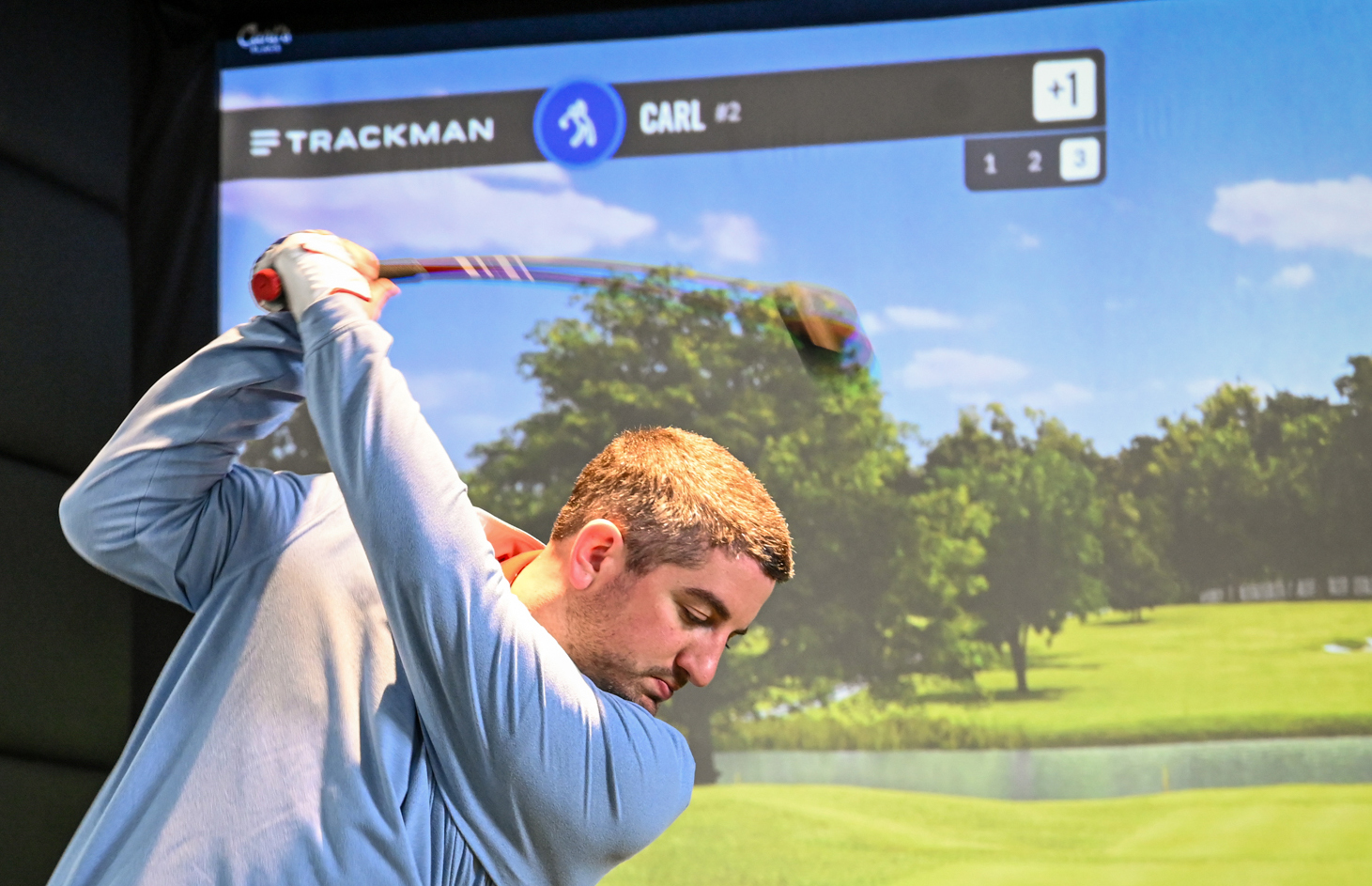Practicing golf at home continues to get easier with advent of new technology, the use of home golf simulators, and online coaching. Whether you’re a beginner looking to get a handle on the fundamentals or an experienced player aiming to fine-tune your skills, practicing at home offers countless benefits.
We spoke with Jayson Nickol to get his thoughts on the best ways to practice golf from the comfort of your home. Nickol is one of the top coaches on the Skillest app, and is PGA and Titleist Performance Institute level 1, Golf 2 certified.
Here’s what Nickol had to say about how to practice golf at home.
How to Practice Golf at Home
Where to Start
If you don’t have any indoor space for a golf simulator, can you really get better by just taking your clubs into your backyard to get some swings in? The simple answer is yes, but Nickol pointed out a couple of caveats.
“You should grab a mat, unless you are OK wrecking your grass - I don't suggest that though. You can put the mat on your lawn and hit balls,” Nickol said. “However, I really suggest starting with a great mat, such as a Fiberbuilt, because you don't want to develop any injuries from hitting off hard, unforgiving mats.”
For those just learning - and to keep the neighbors safe - Nickol is also a fan of foam balls.
"They’re great for learning new movement patterns without the need to try to hit great shots,” Nickol said.
For Beginners: Focus On The Basics
Mastering the fundamentals is key when learning the game, Nickol said.
“I always tell golfers to start with the basics: grip, stance, posture, ball position, and alignment,” Nickol said. “But inside of each of those, there can be changes that would differ from player to player, so finding a great coach will be the best thing you can do. Even if it’s just three lessons to start to nail down the fundamentals.”
“Golf is so funny. Most people get brought into the sport from another friend who plays and they just buy a used set and venture off on their own, ingraining bad habits from the start,” Nickol said. “Having somewhere at home that you can practice (with the help from a coach) is amazing and more golfers would benefit from that.”
For those just getting started with at-home practice, Nickol recommended Adam Young’s Practice Manual, which is full of drills and techniques. He also suggested using foot spray to test your ball striking: spray it on your clubface and see where the ball makes contact.
He added that practicing low-point control is crucial when using a mat. On a hitting mat, if your club’s low point is too far back, your club can bounce off the mat and into the ball, giving you false confidence that you’re striking the ball decently. If you were to do the same swing on a real golf course with actual grass/turf, your club likely wouldn’t bounce and would rather cause a chunked shot.
A simple way to practice low point control is by placing a microfiber towel four fingers behind the ball and avoiding it during your swing.
"If you’re clipping the towel, you’re probably hitting the ground before the ball,” Nickol explained.

For The More Experienced: Know Your Weaknesses
If you’re already a skilled golfer with a single-digit handicap but looking to reach scratch, Nickol’s advice is simple: identify your weaknesses and attack them.
“I’d recommend using strokes gained data or running combines on a simulator to see where you could improve,” he advised.
Once you’ve found your weak spots, it’s time to apply some pressure during practice.
“If you’re struggling with driving accuracy, play a simulated hole with a lake on the right and challenge yourself not to hit it in the water. Every time you do, give yourself a punishment like 10 jumping jacks,” Nickol said. “You need some pressure in practice to mimic real-game situations.”
The Use Of Training Aids
Nickol highlights three must-have training aids for at-home practice:
- Foot spray: This simple tool shows you exactly where you’re hitting the ball on the clubface. “It’s huge for variable training, and most people overlook it,” he notes.
- Video feedback: While not a traditional training aid, Nickol stresses the importance of filming your swing. “It helps train your brain by showing what feels right versus what’s actually happening.”
- Kettlebells: Surprisingly, Nickol recommends kettlebells to help golfers feel weight shifts during their swing. “It’s great for working on pressure shifts and body turns,” he added.
Books and Online Coaching
When it comes to intangible resources, Nickol is a big believer in the power of online coaching.
“Online coaching and home simulators are a match made in heaven,” he says.
Platforms like Skillest make it easy to get lessons on your schedule, from the comfort of your home. You can even book a lesson with Nickol himself through the app.
For reading materials, Nickol recommends Jon Sherman’s “The Four Foundations of Golf” and Mark Broadie’s “Every Shot Counts.” Both books are packed with insights and are must-reads for golfers who are serious about improving.
How Can A Simulator Help You Practice Golf At Home
Here are six ways practicing golf in a simulator can help your game:
1. Quantifiable Data
A key benefit of a simulator is access to detailed performance data. With every swing, you receive metrics such as club speed, ball speed, spin rate, launch angle, and more. This real-time feedback helps you understand how far your clubs carry, how consistent your shots are, and where improvements can be made.
“Getting quantifiable data is huge in golf, knowing truly how far your clubs carry on average would help so many golfers,” Nickol said.
2. Year-Round Practice
For golfers in colder climates, winter can cut practice time short. A simulator allows you to practice and play year-round without worrying about weather conditions. Whether it's freezing outside or raining, your golf game doesn’t have to hibernate.
“The ease to practice and play year round is massive,” Nickol said.
3. Shot Shaping
Beyond just practicing, simulators enable you to work on specific shot shapes.
“For example, if you slice the ball, you can work at home on how to hook the ball, so you can neutralize that slice,” Nickol said.
4. Convenience & Flexibility
With a home simulator, you can practice whenever it's convenient for you. Whether you want to sneak in a quick session before work or have a full practice on a Sunday afternoon, the flexibility of having a simulator at home makes golf more accessible.
Heck, you can even play at 1 a.m. - as long as you don’t wake anybody up.
5. Game-Like Pressure
Many simulators offer game modes and challenges that create real-life pressure situations. You can play against friends online, enter virtual tournaments, or test your skills with skills assessments.
This pressure helps simulate the real on-course experience, making your practice sessions more effective.
6. Cost Efficiency
While an initial investment is required for a simulator, it can save you money over time. No more frequent trips to the driving range or golf course fees. You’ll have your own private practice facility just a few steps away, which could add up to long-term savings.
Is A Golf Simulator The Best Way To Practice Golf At Home?
“Without a doubt,” Nickol answered during his final take. “If you pair a home simulator with proper practice and coaching, you’ll not only improve your game but also have more fun on the course,” he concludes.
Looking to start your own golf instruction business? Check out our tips!